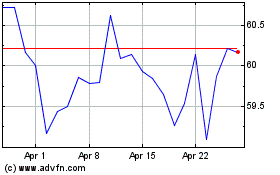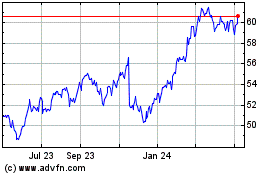Retailer lifts market share in key segments, including groceries
and toys; online orders rise
By Sarah Nassauer
This article is being republished as part of our daily
reproduction of WSJ.com articles that also appeared in the U.S.
print edition of The Wall Street Journal (February 20, 2019).
Walmart Inc. strengthened its grip on American shoppers over the
winter holidays, posting strong sales growth as the world's biggest
retailer lured customers from shrinking chains and ramped up its
online grocery business.
In the U.S., the company's comparable sales, which exclude gas
but include e-commerce sales, rose 4.2% in the January-ended
quarter, one of the behemoth's biggest quarterly gains in a decade.
Walmart got a boost from strong grocery sales, online orders and
holiday purchases including toys. Walmart had expected quarterly
U.S. comparable sales to rise at least 3% from a year earlier.
The results -- following mixed economic data and sales updates
from other U.S. chains -- were mostly better than Wall Street had
expected, and the company reiterated its financial forecasts for
fiscal 2020. Shares of Walmart gained 2.2% to $102.20 on
Tuesday.
"We experienced a favorable economic environment in the U.S. for
much of the year," which helped lift grocery spending, said Walmart
Chief Executive Doug McMillon on a conference call. Mr. McMillon
said the company gained market share in key categories, including
groceries and toys, during the latest quarter.
More than half of Walmart's U.S. revenue comes from food and
other staples, and the retailer boasts of a store within 10 miles
of 90% of Americans. It has fared better than department stores or
mall-based chains that are more heavily reliant on apparel or are
unable to make heavy investments to answer Amazon.com Inc. It has
also benefited from the unraveling of some big-box chains like Toys
"R" Us Inc. and Sears Holdings Corp.
In the latest quarter, the company got a boost when the U.S.
government sent February checks to Supplemental Nutrition
Assistance Program recipients in January to ensure payment amid the
federal government shutdown. The company said the shift added 0.4%
to its comparable sales growth.
Quarterly sales were helped by several one-time factors, said
Simeon Gutman, retail analyst at Morgan Stanley, including tax
reform, SNAP payments in January, and a surge in toy sales after
Toys "R" Us closed. However, Walmart's wider product selection
online and growth of online grocery services "are clearly
resonating with shoppers and Walmart's efforts to capture new
customers are working," said Mr. Gutman.
Walmart said e-commerce sales rose 43% in the latest quarter and
40% for the full fiscal year, hitting the company's expectations
for a small but key part of its business. The growth has been
driven by the expansion of online grocery pickup services to more
than 2,100 of Walmart's 4,600 U.S. stores this fiscal year. Walmart
also started offering online grocery delivery in about 800
stores.
When customers buy online, and then pick up merchandise in store
parking lots, those sales get counted as online sales. Walmart said
U.S. e-commerce growth will slow to 35% this fiscal year.
Overall, Walmart reported a quarterly profit of $3.69 billion,
or $1.27 a share, for the fourth quarter ended Jan. 31, compared
with $2.18 billion a year earlier. Excluding a tax-related charge
and other items, Walmart said it had an adjusted profit of $1.41 a
share. On that basis, Wall Street was expecting earnings of $1.33 a
share.
Total revenue, including the Sam's Club chain and Walmart's
overseas business, was $138.79 billion, up 1.9% from a year ago.
Excluding currency swings, Walmart said total revenue rose 3.1% to
$140.5 billion.
While Walmart reported an increase in visits to its U.S. stores
in the January-ended quarter, it posted a much higher jump in the
average amount spent. As more grocery sales come through online
orders, shoppers tend to spend more per trip, said Walmart's
finance chief Brett Biggs in an interview. Inflation also rose
modestly, he said.
At the same time, Walmart's profit margin declined, a result of
a higher percentage of its sales coming from lower-margin
e-commerce orders, rising transportation costs and online
investments. Walmart expects e-commerce losses to increase for the
current fiscal year, said Mr. Biggs.
Walmart is the first major U.S. retailer to report full
fourth-quarter results. In January, some chains including Target
Corp. and Costco Wholesale Corp. said they had the strongest
holiday sales in years, but others, including Macy's Inc. and
Kohl's Corp., reported sluggish growth.
Meanwhile, Amazon reported a record quarterly profit and said
revenue rose 20% to $72.38 billion, the smallest quarterly jump
since 2015.
Generally, U.S. retailers were buoyed last year by a strong U.S.
economy, high employment and rising wages. However, government data
released last week showed December sales at stores, restaurants and
online fell a seasonally adjusted 1.2% from November, the biggest
monthly drop since September 2009.
For its full year, Walmart booked total revenue of $514.41
billion, with about $331.7 billion coming from its namesake stores
in the U.S. Another $57.8 billion came from its Sam's Club
warehouse chain and about $120.8 billion came from international
stores. The company expects its U.S. comparable sales to rise
between 2.5% and 3% this year.
Outside the U.S., Walmart has been shifting its focus, selling
its retail stores in Brazil and agreeing to merge its U.K. stores
with a rival. The company also struck a deal to spend $16 billion
to acquire Indian e-commerce company Flipkart, a move that it has
warned will weigh on its profits. In the fourth quarter, the
retailer reported strong comparable sales gains in Mexico and a
decline in China.
The company plans to open fewer than 10 U.S. stores this year
and will spend the bulk of its capital investments on remodeling
existing locations and on e-commerce efforts. It expects to open
more than 300 new stores abroad this year, primarily in Mexico and
China.
Since Walmart agreed to buy Flipkart last year, the startup's
CEO Binny Bansal has stepped down and the Indian government has
changed regulations surrounding how foreign e-commerce companies
are allowed to operate. Amazon warned last month those changes
could hurt growth in the country.
"The things that have happened have been disappointing in some
way, but they haven't shaken our confidence and excitement about
what this is going to mean to the company long term" in India, Mr.
McMillon said Tuesday. "We hope to have an effective, productive
dialogue, as it relates to future changes that happen. But in terms
of how the business has behaved, it's in line with what we thought
it would be."
Write to Sarah Nassauer at sarah.nassauer@wsj.com
(END) Dow Jones Newswires
February 20, 2019 02:47 ET (07:47 GMT)
Copyright (c) 2019 Dow Jones & Company, Inc.
Walmart (NYSE:WMT)
Historical Stock Chart
From Mar 2024 to Apr 2024

Walmart (NYSE:WMT)
Historical Stock Chart
From Apr 2023 to Apr 2024
